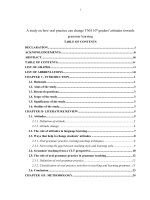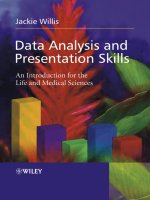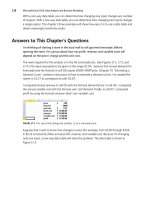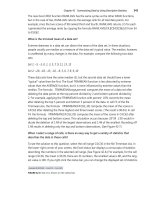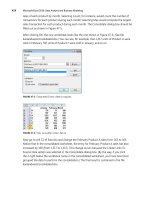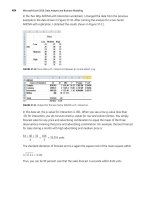Data analysis and modeling for engineering and medical applications
Bạn đang xem bản rút gọn của tài liệu. Xem và tải ngay bản đầy đủ của tài liệu tại đây (1.13 MB, 131 trang )
DATA ANALYSIS AND MODELING FOR ENGINEERING AND
MEDICAL APPLICATIONS
MELISSA ANGELINE SETIAWAN
NATIONAL UNIVERSITY OF SINGAPORE
2009
DATA ANALYSIS AND MODELING FOR ENGINEERING AND
MEDICAL APPLICATIONS
MELISSA ANGELINE SETIAWAN
(B.Tech, Bandung Institute of Technology, Bandung, Indonesia)
A THESIS SUBMITTED
FOR THE DEGREE OF MASTER OF ENGINEERING
DEPARTMENT OF CHEMICAL AND BIOMOLECULAR ENGINEERING
NATIONAL UNIVERSITY OF SINGAPORE
2009
ACKNOWLEDGEMENTS
First of all, I want to thank God who is always with me during my
coursework and research, gives me health and ability for doing all my work, equips
me with hope so I can face failures and keep persisting with my research and
blesses me in every single day of my life.
With all respect, I would like to acknowledge my supervisor, Dr Laksh, for
his guidance during my research. I really learnt a lot from him including how to be
a good researcher, how to conduct research, how to be creative, how to motivate
people and how to be a good teacher. He encouraged me during the difficult times I
went through in the course of my research.
I would like to acknowledge my parents, my little sister and Yudi who
always supports me in prayer, gives advice, cheers me up whenever I felt down, and
reminds me to not lose my hope. Thanks for your love, support, advice, concern,
encouragement, and prayer.
I also want to thank NUS and AUN-SEED Net for giving me the
scholarship and opportunity to pursue my M.Eng degree through research.
I want to take this opportunity to acknowledge all my labmates, particularly
Raghu, who equipped me with professional skills, Yelneedi Sreenivas and Sundar
Raj Thangavelu who always came up with jokes and made the situation in our lab
so cheerful. Thanks to Kanchi Lakshmi Kiran, May Su Tun and Loganathan for
discussions that turned out to be really useful for me. Thank you all for your
friendship, I really enjoy our time together in IPC group.
i
Last but not least, I would like to thank all my best friends who are not
mentioned by name explicitly. Nevertheless, I thank each of you for your
encouragement, support, suggestions, attention, and friendship.
ii
CONTENTS
Page
ACKNOWLEDGEMENTS........................................................................................ i
CONTENTS..............................................................................................................iii
SUMMARY............................................................................................................ viii
NOMENCLATURE .................................................................................................. x
LIST OF TABLES................................................................................................... xii
LIST OF FIGURES ................................................................................................ xiv
1. INTRODUCTION ................................................................................................. 1
1.1
INFORMATION BASED SOCIETY – RESEARCH BACKGROUND ...................... 1
1.2
ANALYSIS TECHNIQUES IN DATA RICH AREA – PROBLEM DEFINITION ...... 2
1.3
MOTIVATION AND CONTRIBUTIONS ............................................................ 4
1.4
CHALLENGES IN DATA ANALYSIS AND MODELING WORK ......................... 5
1.5
SCOPE OF PRESENT WORK .......................................................................... 5
1.6
ORGANIZATION OF THE THESIS .................................................................... 6
2. SUPERVISED PATTERN RECOGNITION ........................................................ 7
2.1
VARIABLE
SELECTION .............................................................................. 10
2.1.1
Fisher criterion ..................................................................................... 11
2.1.2
Entropy method................................................................................... 11
2.1.3
Single variable ranking (SVR)............................................................. 12
2.1.4
Partial Correlation Coeficient Metric (PCCM).................................... 12
2.2
MACHINE LEARNING METHODS .............................................................. 13
iii
2.2.1
Artificial Neural Network (ANN)........................................................ 13
2.2.2
TreeNet ................................................................................................ 13
2.2.3
Classification and Regression Trees (CART)...................................... 14
2.2.4
Linear/Quadratic Discriminant Analysis (LDA/QDA)........................ 16
2.2.5
Variable Predictive Model based Class Discrimination (VPMCD) .... 17
2.2.6
K-nearest neighbour (K-NN) ............................................................... 17
2.2.7
Support Vector Machine (SVM).......................................................... 18
2.3
MODEL VALIDATION ................................................................................ 19
2.3.1
Resubstitution test................................................................................ 20
2.3.2
N-fold Cross-validation ....................................................................... 20
2.3.3
Independent Test.................................................................................. 20
2.3.4
Leave one out cross-validation (LOOCV) test .................................... 21
3. PARTIAL CORRELATION METRIC BASED CLASSIFIER FOR FOOD
PRODUCT CHARACTERIZATION ..................................................................... 22
3.1
INTRODUCTION ................................................................................... 22
3.2
METHODS .............................................................................................. 24
3.2.1
Concept of partial correlation coefficients........................................... 24
3.2.2
Discriminating Partial Correlation Coefficient Metric (DPCCM)....... 27
3.2.3
DPCCM Algorithm.............................................................................. 29
3.2.4 DPCCM illustration with Iris data ....................................................... 31
3.2.5
Other classifiers used for comparison.................................................. 34
iv
3.2.6 Validation methods ............................................................................... 36
3.2.6.1 Re-Substitution Test...................................................................... 36
3.2.6.2 Random Sample Validation Test .................................................. 37
3.3
MATERIAL............................................................................................. 37
3.3.1
Datasets ................................................................................................ 37
3.3.2
Implementation .................................................................................... 39
3.4
RESULTS ................................................................................................... 39
4. ANALYSIS OF BIOMEDICAL DATA ............................................................. 46
4.1
INTRODUCTION ................................................................................... 46
4.2
METHODS .............................................................................................. 49
4.2.1 Classification Methods......................................................................... 49
4.2.2
4.3
Variable Selection Methods................................................................. 50
MATERIALS AND IMPLEMENTATION............................................. 51
4.3.1
Datasets ................................................................................................ 51
4.3.1.1 Anesthesia Dataset ........................................................................ 51
4.3.1.2 Wisconsin Breast Cancer (WBC) dataset ..................................... 52
4.3.1.3 Wisconsin Diagnostic Breast Cancer (WDBC) dataset ................ 52
4.3.1.4 Heart Disease dataset .................................................................... 53
4.3.2
Implementation .................................................................................... 53
4.3.3
Model Development............................................................................. 54
4.3.4
Validation Testing................................................................................ 54
4.3.5
Variable Selection................................................................................ 55
4.3.6
Software ............................................................................................... 56
v
4.4
RESULTS ................................................................................................ 56
4.4.1
Parameter Tuning................................................................................. 56
4.4.2
Test set Analysis .................................................................................. 57
4.4.2.1 DOA classification........................................................................ 57
4.4.2.2 Classification with WBC dataset .................................................. 65
4.4.2.3 Classification with WDBC dataset ............................................... 67
4.4.2.4 Heart Disease Identification.......................................................... 68
4.4.3
Variable Selection................................................................................ 69
5. EMPIRICAL MODELING OF DIABETIC PATIENT DATA .......................... 75
5.1 INTRODUCTION ....................................................................................... 75
5.2 FIRST ORDER PLUS TIME DELAY (FOPTD) MODEL...................................... 78
5.3 MATERIALS AND IMPLEMENTATION ................................................ 79
5.3.1
Dataset and Software ........................................................................... 79
5.3.2
FOPTD Implementation....................................................................... 82
5.4
RESULTS AND DISCUSSION .............................................................. 83
5.4.1
Patients with Continuous Insulin Infusion (Group 1) .......................... 83
5.4.2
Patients with Intermittent Insulin Infusion (Group 2).......................... 85
5.4.3 Patients with Blood Glucose Response Affected by Other Factors
(Group 3).............................................................................................. 87
5.4.4
Medication Effect................................................................................. 89
5.4.5
Analysis of Home Monitoring Diabetes Data...................................... 92
6. CONCLUSIONS AND RECOMMENDATIONS .............................................. 99
vi
6.1 CONCLUSIONS ............................................................................................... 99
6.2 RECOMMENDATIONS................................................................................... 101
REFERENCES ...................................................................................................... 105
APPENDIX A. CV of the Author.......................................................................... 114
vii
SUMMARY
Information revolution has slowly but surely turned us into an information
based society. As a result, data (as one form or source of information) collection
and interpretation holds an important role in obtaining good information. In this
thesis, some machine learning techniques are elaborated and applied to some
classification problem exists in food industry and medical field. In addition, the use
of First Order Plus Time Delay (FOPTD) to model ICU patient blood glucose is
also proposed here.
In the present study, a newly developed classifier (DPCCM) is utilized to
address both Cheese and Wine identification problems and disease identification
problems (using WBC and WDBC). Its performance was then compared with other
well established classification methods. The comparison results in Cheese and Wine
identification problems show that DPCCM has better performance than linear
classifiers and comparable result to non-linear SVM classifiers. It also provides
good visualization for understanding the specific variable interactions contributing
to the nature of each class. DPCCM consistency in its performance is even shown
in disease identification problems since it has better performance, in terms of
overall accuracy, than other classifier used in this study. To conclude, DPCCM
shows better potential to be an efficient data analysis tool for both clinical diagnosis
and food product characterization.
The performance analysis of machine learning techniques in medical field is
also done by applying some of those techniques to do depth of anesthesia (DOA)
classification and heart disease identification. According to our analysis, in terms of
overall accuracy, CART and QDA are observed to be the best classifier models for
viii
DOA classification using cardiovascular features and AEP features respectively.
Even when classifiers are built using a subset of features, the superiority of CART
and QDA in DOA classification using cardiovascular dataset and AEP features
respectively is confirmed. Our analysis in heart disease identification study shows
that TreeNet gives much better overall accuracy and gives lower class 2
classification performances compared to CART in both overall accuracy and class
wise accuracy.
The last stage of this study is to model ICU patients’ blood glucose value
using FOPTD (First Order Plus Time Delay) as the proposed model. The
performance of FOPTD is then compared with Bergman and Chase models.
According to the study, FOPTD successfully fits and predicts the actual patient data
for all datasets received from the hospital. In addition, its performance is much
better than the other two established models not only for good datasets but also for
atypical datasets. Moreover, its simplicity makes this model easy to be applied and
modified according to the input availability of the dataset.
ix
NOMENCLATURE
A, B, C, X, Z - selected variable in a given system
AEP, CV, WBC, WDBC, HEART – subscripts used to identify the name of dataset
AEP – Auditory Evoked Potential
ANN – Artificial Neural Network
CART – Classification and Regression Trees
CO – Cost Optimization
CoV – Coefficient of Variance
DOA – Depth of Anesthesia
DPCCM – Discriminating Partial Correlation Coefficient Metric
FC – Fisher Criteria
FOPTD– First Order Plus Time Delay
HR – Heart Rate
LDA – Linear Discriminant Analysis
M – correlation coefficient matrix
MAE – Mean Absolute Error
MAP – Mean Arterial Pressure
N – data matrices used in training
P – data matrices
PCCM – Partial Correlation Coefficient Metric
PNN – Probabilistic Neural Network
QDA – Quadratic Discriminant Analysis
SAP – Systolic Arterial Pressure
SVM – Support Vector Machines
x
SVR – Single Variable Ranking
VPMCD – Variable Predictive Model based Class Discrimination
WBC – Wisconsin Breast Cancer dataset
WDBC – Wisconsin Diagnostic Breast Cancer dataset
d – number of correlations defined in the system
i, j, k – subscripts used to identify the variables
k - number of classes
l – number of samples in a class
n - number of observations
p - number of variables
r - correlation coefficient
r – subscript used to represent reduced dataset
test – subscripts used to represent test data matrices used in model validation
x – order of partial correlation
xi
LIST OF TABLES
Page
Table 3.1 Classification result for case study I (WINE classification).................. 40
Table 3.2 Classification result for case study II (CHEESE classification)............ 41
Table 4.1 Summary of parameter tuning result using validation dataset for
anesthesia ............................................................................................... 58
Table 4.2 Summary of parameter tuning result using validation dataset for
breast cancer .......................................................................................... 59
Table 4.3 Summary of parameter tuning result using validation dataset for
heart disease........................................................................................... 60
Table 4.4 Classification result (correct classification) on test set using
cardiovascular features as predictors ..................................................... 60
Table 4.5 Classification results (correct classification) on test set using AEP
features as predictors.............................................................................. 61
Table 4.6 Sensitivity and specificity values for each classifier in DOA
classification .......................................................................................... 64
Table 4.7 Analysis result for WBC dataset using LDA, CART, TreeNet,
DPCCM and VPMCD............................................................................ 66
Table 4.8 Analysis result for WDBC dataset using LDA, CART, TreeNet,
DPCCM and VPMCD ........................................................................... 67
Table 4.9 Classification result on heart disease dataset using CART and
TreeNet .................................................................................................. 69
Table 4.10 Variables selected from 10 AEP features using different selection
methods ................................................................................................ 70
Table 4.11 Variables selected from 3 variables in cardiovascular dataset using
different selection methods.................................................................. 70
Table 4.12 Model accuracy using selected variables (AEP dataset) ..................... 72
Table 4.13 Model accuracy using selected variables (cardiovascular dataset)...... 72
Table 5.1 MAE values for training and test samples using data from patients with
continuous insulin infusion.................................................................... 84
xii
Table 5.2 MAE values for training and test samples using patient data with
intermediate insulin infusion................................................................. 86
Table 5.3 MAE values for training and test samples using Group3 patient data... 88
Table 5.4 Range of the parameters for each patient group .................................... 92
Table 5.5 MAE value for training and test samples using home monitoring
data......................................................................................................... 94
Table 5.6 Range of estimated parameters for home monitoring data .................... 95
xiii
LIST OF FIGURES
Page
Fig. 3.1 PCCM profiles for IRIS data .................................................................... 32
Fig. 3.2 Variable correlation shade map for each class in CHEESE
classification dataset ................................................................................ 43
Fig. 5.1 FOPTD model scheme (MISO system).................................................... 79
Fig. 5.2 Data from Patient 1 who belongs to the first Group................................. 81
Fig. 5.3 Results for the “best” patient data set using the FOPTD model............... 84
Fig. 5.4 Results for the “worst” patient data set using the FOPTD model ............ 85
Fig. 5.5 Results for the “best” patient data set using the FOPTD model
(Intermittent Insulin Infusion)................................................................... 86
Fig. 5.6 Model performance on the “best” patient data from Group 3 .................. 88
Fig. 5.7 FOPTD prediction without medication for Patient 27.............................. 89
Fig. 5.8 FOPTD prediction with medication for Patient 27................................... 90
Fig. 5.9 FOPTD prediction without medication for Patient 34.............................. 90
Fig. 5.10 FOPTD prediction with medication for Patient 34................................. 91
Fig. 5.11 Results with the FOPTD model for the patient with the highest
MAE (home monitoring dataset) ............................................................ 94
Fig. 5.12 Results with the FOPTD model for the patient with the lowest
MAE (home monitoring dataset) ............................................................ 95
Fig. 5.13 Actual glucose and model fit for all 5 home monitoring patients .......... 96
Fig. 5.14 Actual glucose and model prediction for all 5 home monitoring
patients .................................................................................................... 97
xiv
Chapter 1
Introduction
As a general rule, the most successful man in life is the man who has
the best information
Benjamin Disraeli (1804-1881)
Former British Prime Minister
1.1 Information Based Society – Research Background
Fishing and hunting marked the first stage in human history where humans
were primarily engaged in efforts to fulfill their nutritional needs. Increase in
population led to the use of agriculture and domestication of animals. Later, the
improvement in their creativity and way of thinking initiated the enhancement of
civilization. Concurrently with the invention and utilization of stones, wood and
their derivatives, civilization enhancement led to the invention and advancement of
technology. One biggest event that marked technological enhancement happened in
late 18th century is the industrial revolution (Halsall, 1997; Gascoigne, 2008). In
the early stages of industrial revolution, which began in Great Britain (circa 1730),
a machine was introduced to the industrial domain through the invention of steam
engine. The turning point and great transition from manual labor based industry to
machine based manufacturing environment resulted in both positive and negative
impact on the society at that time. Continuous development and improvement of
machines has facilitated life style transformation in the society (Kelly, 2001). Dr.
Earl H. Tilford (2000) writes about an unnoticed impact of industrial revolution
which is currently underway – the information revolution.
1
Information revolution has slowly turned us into an information based
society. While ‘information’ was always useful for human development, it is
becoming a basic need along with food, clothing and shelter. Some facts that
highlight the importance of information in today’s drive towards a knowledge based
economy are the ubiquitous cell phone and the exponential increase in the use of
internet. Ten years ago, cell phone was not that common. Its unaffordable price
made it a luxurious item at that time. The escalation of human needs in information
has encouraged cell phone manufacturers to provide additional application features,
such as radio, internet application (WIFI), Bluetooth, street directory, GPS etc at
low cost. Therefore, almost all people own a cell phone nowadays – even in
developing countries. In addition, the development of internet has paved way for
quicker and reliable information exchange with various information resources and
services such as electronic mail, online chatting, file transfer, file sharing, and other
World Wide Web (WWW) resources. As reported by internet world statistics usage,
the number of internet users has doubled in the last 8 years (2000-2008). In Africa
and Middle East, the internet user growth has even increased by 1000% during the
same period (Anonymous, 2001). These facts highlight the huge “need” for
information among people and provide solid proof that our society is transforming
into an “information based society”. As a result of this transformation, data and
information have a great effect in decision making in various spheres of human
activity. To satiate this hunger for accurate and quick information, methodologies
that can generate accurate information from raw data must be developed.
1.2 Analysis Techniques in Data Rich Area – Problem Definition
High quality information at a high speed is sought by many people in all
walks of life. This is more so with people engaged in business, research, or
2
manufacturing. Before we discuss further about information, its existence and its
importance, it will be better for us to define information. The Oxford English
Dictionary defines information as things that are conveyed or represented by a
particular sequence of symbols, impulses, etc (Oxford, 2005). Based on this
definition, we can come to a conclusion that data is one form or source of
information. As a consequence, data collection and interpretation holds an
important role in obtaining good information.
Even 10-20 years ago, data was scarce due to the relative non-availability of
analytical instruments. Even if an instrument existed, its ability was very limited
and it took quite a long time to get the results. For example, in order to check the
existence of cancer cells, the doctor had to take sample cells from the organ and
check them for any abnormalities manually (using a microscope). This procedure
took even one or two days per sample. The complexity of this conventional method
made it overwhelming when the physician had to differentiate between two nearly
identical cancers in order to give the right treatment for the patient. Luckily,
nowadays, improvements in technology have enabled the collection of samples in a
short time. Modern instruments with ability to simultaneously analyze several
samples and provide results within minutes are now available. This has resulted in a
deluge of data leading to a new problem – the challenge of sifting through this mass
of data and extracting useful information from it can be quite formidable. This is
true of data sets arising from life sciences, chemistry, pharmaceutics (drug
discovery), process operations and even medicine. Methods that can extract useful
information from data are needed and are in fact being developed actively by many
research groups.
3
1.3 Motivation and Contributions
The abundance of data available especially in food engineering and
medicine sector has become a significant problem because they contain precious
information. Since this information will facilitate the doctor and food engineer to
make good decisions which then lead to some improvement in those areas, they
have to be extracted from those datasets. The needs of information extraction have
become a strong motivation in this research.
The research was conducted as a contribution to food engineer and medical
practitioner which is finally useful for the society in many aspect of their life
especially in food quality and medicine. An excellent classification of food product
characterization using data mining technique may help food industry quality control
with relatively lower cost than the taster. Hence the production cost could be lower
and selling prices could be decreased for the convenient of the consumer.
The fact that machine learning technique could accurately be used for
disease identification and DOA classification is very important not only for the
doctor but also for the patient. The doctor may apply machine learning technique
and use the result as a basis to make decisions whether or not the patients need
further treatment. In addition, the use of machine learning technique could also be
an advantage for the patient because they do not have to take so many medical tests
which take a lot of time and very costly.
The ability of First Order Plus Time Delay (FOPTD) in modeling ICU
patients’ blood glucose value as a function of food, glucose and insulin could help
the doctor to predict the amount of glucose and insulin to be administered to the
patient to avoid hypoglycemia and hyperglycemia. Hence it will increase the
number of survive patient in the ICU.
4
1.4 Challenges in Data Analysis and Modeling Work
There are some challenges in doing data analysis and modeling work. The
main one relates to dealing with data complexity. The success of data analysis and
modeling efforts is highly dependent on the data set itself. Poor quality and/or
quantity of data as well as missing data can make data analysis even harder. Some
biological and medical datasets are too huge in size. Therefore, it is a bit too hard
for some computers to handle this kind of dataset owing to limitations of hardware
and software. Unknown noise and disturbances affecting the system can make
modeling difficult even if sufficient number of samples is available. In addition, the
complexity of the physical, chemical and biological phenomena occurring inside
the system accentuates the modeling difficulties. To keep the model simple, data
pretreatment methods such as filtering, sample section and variable selection may
be needed as well.
1.5 Scope of Present Work
Some works related to data analysis and information extraction are
addressed in this present study. They are:
•
Evaluating the performance of a newly developed method (DPCCM) by
implementing it on problems from various domains such as food quality and
medicine (cancer identification and depth of anesthesia classification) and
comparing its performance with some existing leading machine learning
methods.
•
Applying and evaluating selected variable selection methods to improve
classifier performance on medical data sets.
5
•
Identifying the limitations of existing blood glucose modeling methods in
diabetics (surgical ICU patients and patients under home monitoring) and
evaluation of a new modeling methodology.
Section 1.6 provides more detailed information of this work. This present
work mainly focuses on information extraction and data analysis covering food
product characterization problems, early identification of some chronic illness,
DOA (depth of anesthesia) level maintenance and blood glucose modeling in
diabetic patients. Various existing classification, variable selection, and model
fitting methods are studied.
1.6 Organization of the Thesis
Chapter 2 of this thesis will provide an overview on existing data analysis
methods. Both variable selection methods and classification methods are reviewed.
For all the methods, basic information about their working and their
limitations/advantages are discussed. A newly proposed classification methodology,
DPCCM is introduced in chapter 3. Herein, the performance of DPCCM is
compared to some existing and established classification methods such as CART,
Treenet, and LDA. Chapter 4 discusses data mining in the context of medical
applications. Some classification methods are applied and evaluated for early
detection of cancer, heart disease identification and for DOA level maintenance
during surgery process. The role of variable selection methods in classifier
performance is also addressed here. After doing classification and data analysis, in
Chapter 5 of the thesis, the challenging task of modeling of blood glucose data from
ICU patients and patients under home monitoring are considered. Chapter 6
contains the conclusions, a summary of the contributions and possible future work.
6
Chapter 2
Supervised Pattern Recognition
The difficulty of literature is not to write, but to write what you mean;
not to affect your reader but to affect him precisely as you wish
Robert Louis Stevenson (1850-1894)
Scottish essayist, poet and book author
Machine learning and data analysis works by learning from historical or past
experimental data. Facilitated by supervised pattern recognition, a prediction on the
outcome can be done using information available on the attributes (inputs).
Currently, many problems in manufacturing, business and medical domains (e.g.
process monitoring, disease detection and depth of anesthesia (DOA) estimation)
are related to classification problem. For such problems, supervised pattern
recognition uses data from past and existing samples in each class and builds
discrimination rules/models so that one can distinguish between classes. The aim of
constructing the classifiers is to predict to which class the new samples would
belong to. With this prediction, the analyst is able to take the best next step
(Berrueta et al., 2007). Therefore, data analysis is useful for decision making and
can help to improve industrial processes, medical treatment and business outcomes.
Some supervised pattern recognition methods exploit inter-class variations
existing in the samples to build the classification model. In this case, the classifier
tries to identify the main difference between classes. These discriminating
conditions are then applied to a new future sample which is then classified
accordingly. The Classification and Regression Tree (CART) method applies this
7
approach for classification. On the other hand, methods such as Variable Predictive
Model based Class Discrimination (VPMCD) make use of the specific similarities
that exist in each class to build the classification model. VPMCD basically tries to
find out the similarities that exist between the samples in each class. When a new
sample comes, it is checked for its class-specific properties and then categorized
into its corresponding class.
Berrueta et al. (2007) state that data analysis can be envisioned as 4
algorithmic steps. The first one is data set division. In this step, the complete data
set is usually divided into training set and validation set (or test set). The portion of
the division is usually 80% for training set and 20 % for test set (or 75% for training
set and 25% for test set). The training set is then used to build the classification
model and the test set is kept aside for validation purposes.
The second step is data pretreatment. This step is done to facilitate the next
step namely classification or information extraction and to avoid making wrong
conclusions from the dataset (Berrueta et al., 2007). Common data pretreatment
methods available for multivariate data analysis include scaling, weighting, missing
data handling and variable selection. During the experiment, some features or
attributes may be measured and characterized by using different instruments or
machines. Also, the variables recorded may have different orders of magnitude. For
such cases, weighting and scaling is usually applied to make the input variables
have the same basis. In weighting, different weights can be assigned for each
variable such that they have appropriate contributions on the output (weighting is
related to scaling). Some examples of scaling methods are mean centering
(subtracting features value by its variable average value), standardization (dividing
the mean centered value by its standard deviation), normalization (dividing all
8
values in each variable by the square root of its sum of squares), and normalization
variable (variables are normalized with respect to single variable) (Berrueta et al.,
2007).
Data received from hospitals and other sources may also contain missing
data. Data imputation is one method developed to handle missing data. It replaces
the missing value with estimated values. Some techniques replace the missing value
with the mean value of the variable (Little and Rubin, 1986; Zhang et al., 2008).
However, this method assumes there are no dependencies between the variables and
may distort other statistical properties of the data. The other well known imputation
method is hot deck imputation. In this method, missing value is replaced with the
value from other row which is similar to the row with missing value (Rilley, 1993;
Dahl, 2007). Regression imputation and decision tree imputation can also be used to
predict missing value. In regression imputation, missing data is predicted by
regression equation built using the other variables which contain no missing value.
Similarly, for decision tree imputation, a decision tree is built using rows which
have no missing value and the variable with missing value acts as the target
variable. The missing value is then predicted by applying this decision tree to the
row with missing value (Jagannathan and Wright, 2008). Variable selection is
needed when we deal with huge datasets so as to minimize the computational time
and make model or classifier construction relatively easy. Variable selection will be
discussed in detail in section 2.1. In this thesis, we only focus on variable selection
method (Chapter 4) and centering method (Chapter 5) because the dataset used is
relatively large and there is no missing data in the datasets.
The third step is classification model building. In this step, all information
contained in the training data set (excluding test set) is used to build the
9
